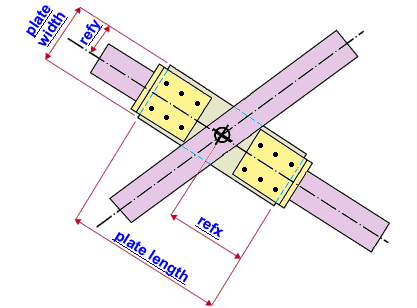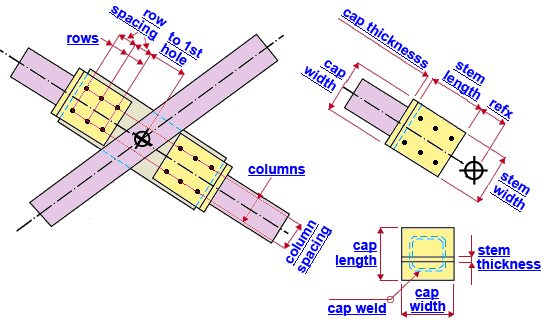"  Gusset Intersection " & "
Gusset Intersection " & "  Brace Connection To Gusset Hss Bolted " connection design locks
Brace Connection To Gusset Hss Bolted " connection design locks
| HSS horizontal braces field bolt to an intersection plate. The braces can have welded tee end fittings (shown), or other " Pipe tube end fittings " (not shown). An erection bolt is provided for shop attaching the intersection plate to the supporting center brace. The intersection plate's " Length " runs parallel with the two supported HSS horizontal braces. |
"  |
"  |
Connection Guide: Click here or here for related screen shots.
User Defined Connections: Settings that are locked (
) in a user defined connection file will automatically be locked on a member edit window for which that file is the " Input connection type ." You can, if you so choose, manually lock additional settings on the member edit window, and your changes will be retained, through multiple processes, so long as you do not change to a different connection then switch back to the original user defined connection.
Horizontal Brace Edit: To change a setting, first set it to locked (
). Related settings that are unlocked (
) may be updated, and the "
Left/Right end limit state " calculations will be updated. Settings that are locked (
) will not be changed by connection design , even if doing so might prevent a connection failure.
Connection design locks :
| Locks not dimensioned or called out on the drawings are marked ( not depicted ). |
![]() Gusset Intersection
Gusset Intersection
Thickness ( not depicted ): The " Material thickness " of the intersection plate.
The thickness is centered with respect to the work line of the supporting horizontal brace.
Width: The distance (perpendicular to the work line of either of the supported braces) between the two edges of the intersection plate that are parallel with the supported braces' work lines (see example ). In other words, this is the length of either of the two short edges of the intersection plate.
Increasing the plate " Width " on both of the supported braces adds material down, toward the bottom of your computer screen in a plan view.
Tip: The plate " Width " is symmetrical around the work lines of the two supported braces if the " Y-reference " is half the distance entered here.
Length: The distance (parallel with the work line of either of the supported braces) between the two edges of the intersection plate that are perpendicular to the supported braces' work lines (see example ). In other words, this is the length of either of the two longer edges of the intersection plate.
Increasing the plate " Length " on both of the supported braces adds material to the end of the plate associated with the left brace.
Tip: The plate " Length " is symmetrical around the work point shared by the two supported braces if the " Refx " is half the distance entered here.
Refx: The distance (parallel with the work line of the supported brace) from the work point to the edge of the intersection plate that the right horizontal brace frames to (see example ).
Increasing the " Refx " on both of the supported braces shifts the center of the intersection plate toward the right brace. Changing the " Refx " moves the plate only, not the holes on the plate.
Refy: The distance (perpendicular to the work line of either of the two supported braces) from the work point to the upper longer edge of the intersection plate (the upper edge is the edge that is higher on screen in a plan view -- see example ).
Increasing the " Refy " on both of the supported braces shifts the intersection plate upward in a direction perpendicular to the work lines of the supported braces. Changing the " Refy " moves the plate only, not the holes on the plate.
![]() Brace Connection To Gusset Hss Bolted
Brace Connection To Gusset Hss Bolted
Thickness: The distance between the top and bottom faces of the stem plate. For a perfectly horizontal horizontal brace, increasing the " Thickness " moves the bottom surface of the stem plate down, while the top surface remains at the same elevation. See example .
Width: The distance between the two corners of the forward edge of the stem plate. Since the stem plate is rectangular, this is also the length of the edge of stem plate that welds to the cap plate. The width of the plate is perpendicular to the work line of the horizontal brace. See example .
Length: The length of either of the two edges of the stem plate that are parallel with the work line of the horizontal brace. See example .
Refx: The distance (parallel with the work line of the horizontal brace) from the work point of the horizontal brace to the nearest edge of the stem plate (to its forward edge). Increasing the " Refx " stretches the stem plate and moves the cap plate along the work line toward the opposite end of the horizontal brace -- it does not move the holes in the plate since hole placement is set on the gusset plate. You may need to also adjust the " Minus dimension " for this end of the brace if you adjust the " Refx ." See example .
Refy ( not depicted ): The distance (perpendicular to the work line of the horizontal brace) from the work line of the horizontal brace to the length edge of the stem plate (the length edge is parallel with the work line). Changing the " Refy " slides the stem plate sideways (moves it perpendicular to the work line) -- it does not move the holes in the plate since hole placement is set on the gusset plate.
Refz ( not depicted ): The distance (perpendicular to the work line of the horizontal brace) from the horizontal brace work point to the top face of the stem plate. For a perfectly horizontal horizontal brace, this distance is vertical. A " Refz " of ' 0 ' places the top surface of the stem plate flush with the bottom surface of the gusset plate. Increasing the " Refz " moves the stem plate down, away from the gusset plate.
Weld: The weld size for shop welding the back edge (top and bottom) of the stem plate to the cap plate. This is labeled "stem weld" in the example .
Stem plate to gusset connection
Hole type ( not depicted ): Standard round or Short slot or Oversized or Long slot or User slot #1 or User slot #2 . This sets the hole type hole type for all bolts on the horizontal brace intersection plate. If you enter a different " Hole type " for each of the two supported horizontal braces, connection design uses the hole type entered for the left brace. A horizontal brace intersection plate is a submaterial of the supporting pipe or tube brace and field bolts to the two supported braces.

Bolt diameter ( not depicted ): The diameter of the field bolts to be used to fasten the supported brace you are editing to the intersection plate. You can either type in any diameter (inches or mm), or you can select a bolt diameter from the combo box (
). The diameters that are listed in the combo box come from Home > Project Settings > Job > Bolt Settings > the " Available bolts " list. The bolt diameter entered here, along with the " Hole type " entered above, together set the diameter of the holes the bolts goes into. The two supported braces can be bolted to the intersection plate with different bolt diameters.
Rows: The total number of holes in a column of holes on the half of the intersection plate associated with the brace that you are editing. Bolt row spacing on a horizontal brace intersection plate runs parallel with the work lines of the two supported horizontal braces (see example ). For the example above, the number of " Rows " is ' 3 '. Both braces should have the same number of rows.
Distance to 1st hole along brace: The distance (parallel with the work line of the supported brace that you are editing) from the work point to the first row of holes on the half of the intersection plate you are editing (see example ).
Hole spacing along brace ( row spacing ): The distance (center to center) between of any two adjacent holes in the same column of holes on the half of the intersection plate associated with the supported brace you are editing (see example ).
End connection failure message: Invalid bolt spacing
Columns: The number of columns of holes for bolting either of the supported braces to the intersection plate. For the example above, this number is ' 2 '.
Hole spacing perpendicular to brace ( column spacing ): The distance (center to center) between columns of holes (see example ). Bolt column spacing runs perpendicular to the work line of the horizontal brace.
Thickness: The " Material thickness " of the cap plate. Increasing the cap plate " Thickness " moves the back face of the cap plate toward the opposite end of the horizontal brace, while the forward face of the cap plate remains the same distance from the work point. See example .
Width: On a horizontal brace that is perfectly horizontal, this is the length of either of the horizontal edges of the cap plate. See example .
Length: On a horizontal brace that is perfectly horizontal, this is the length of either of the vertical edges of the cap plate. See example .
Refx ( not depicted ): The distance (perpendicular with the work line of the horizontal brace) from the work line of the horizontal brace to the length edge of the cap plate. For a horizontal brace that is perfectly horizontal, this distance is horizontal. Changing the " Refx " slides the cap plate sideways.
Refy ( not depicted ): The distance (perpendicular with the work line of the horizontal brace) from the work line of the horizontal brace to the top edge of the cap plate. For a horizontal brace that is perfectly horizontal, this distance is vertical. Changing the " Refy " slides the cap plate up or down.
Weld size: The weld size for shop welding the pipe or tube horizontal brace to the cap plate. This is labeled "cap weld" in the example .







